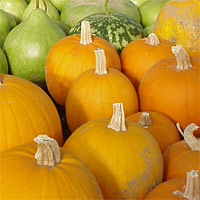Pumpkin

A type of squash, pumpkins are best known as a Halloween decoration, but many varieties are also excellent substitutes for winter squash in soups and stews.
About This Plant
Pumpkins are the quintessential fall crop in many parts of the country. There are many varieties to choose among. Some are best for carving into jack-o-lanterns, some are bred for cooking and still others were developed just for their tasty seeds. The "Atlantic Giant" types were bred purely for size -- they can be truly enormous. Pumpkins are grown similarly to winter squash and require plenty of space to vine.
Site Selection
Select a site with full sun to light shade and well-drained soil. Prepare the garden bed by using a garden fork or tiller to loosen the soil to a depth of 12 to 15 inches, then mix in a 2- to 4-inch layer of compost.
Harvesting
The first sign of a ripening pumpkin is a deep skin color. To make sure it's truly ready to pick, thump the pumpkin with your fingers -- a ripe pumpkin will sound hollow. A final test is to press your fingernail into the skin. If it resists puncture, it is ripe.
Use a sharp knife or pruners to cut the fruit from the vine. Leave a long stem on the pumpkin to serve as a handle.
Planting Instructions
Pumpkins require a long growing season -- from 75 to 100 frost-free days. Plan to sow seeds directly in the garden after all danger of frost has passed and the soil has warmed. Plant six seeds 1 inch deep in a circle about 2 feet across. Space these circles 2 to 3 feet apart in rows 6 to 8 feet apart. Cover the seeds with soil. In the far north start seeds indoors 3 to 4 weeks before the last frost. Set out two to three transplants per circle after all danger of frost has passed and the plants have about six leaves.
Care
When several true leaves have appeared, thin each direct-seeded circle to the healthiest two or three plants. Mulch to keep weeds down; do not over cultivate or the shallow roots may be damaged. Water plants during the summer if rainfall is less than 1 inch per week. Pinch off the fuzzy ends of each vine after a few pumpkins have formed. Contact your local County Extension office for controls of common pumpkin pests such as cucumber beetles and squash bugs.






 A type of squash, pumpkins are best known as a Halloween decoration, but many varieties are also excellent substitutes for winter squash in soups and stews.
A type of squash, pumpkins are best known as a Halloween decoration, but many varieties are also excellent substitutes for winter squash in soups and stews.